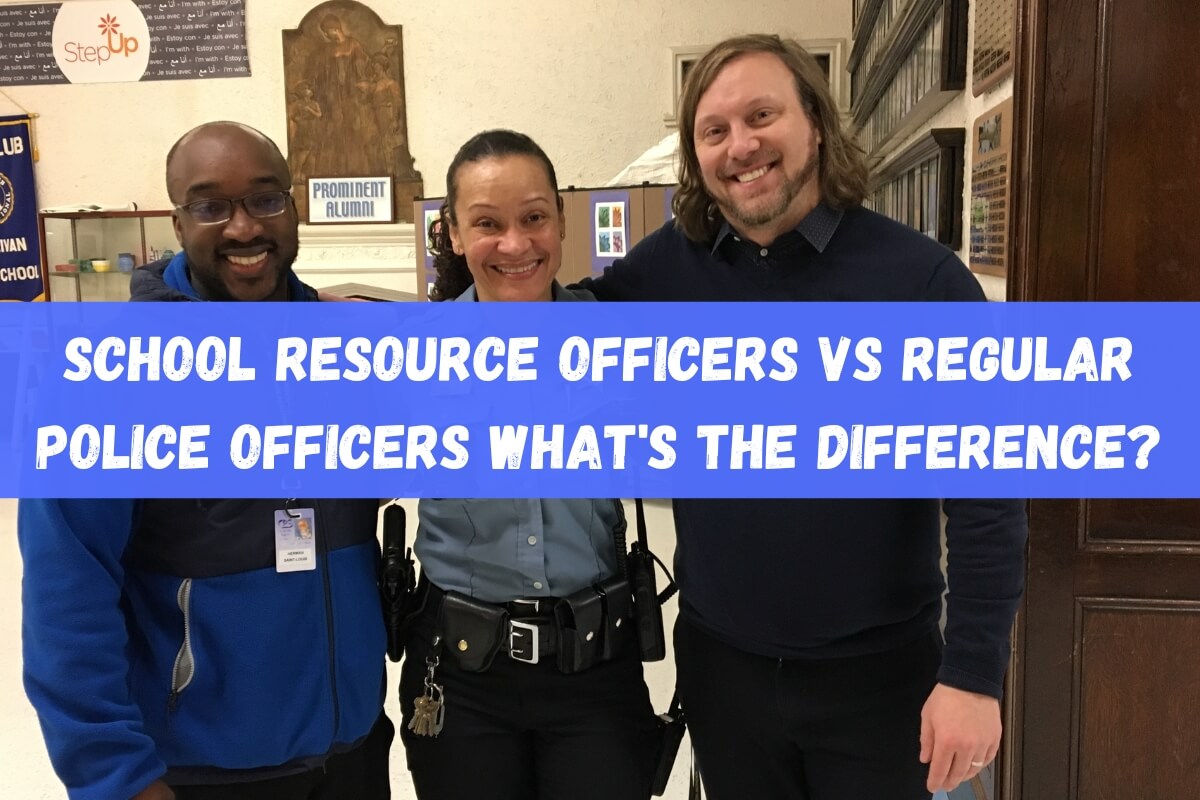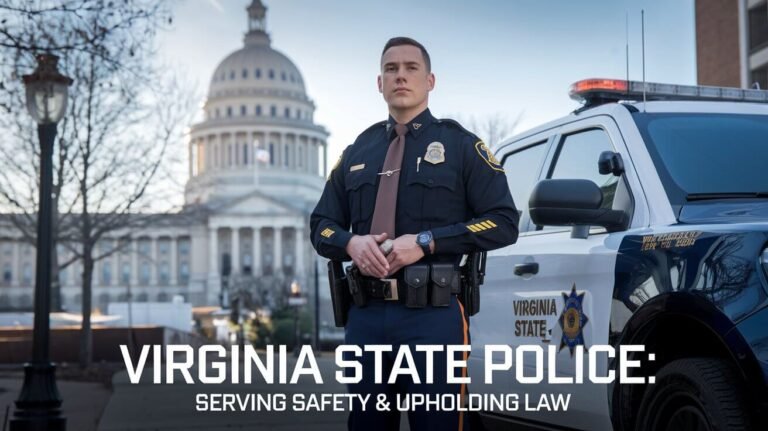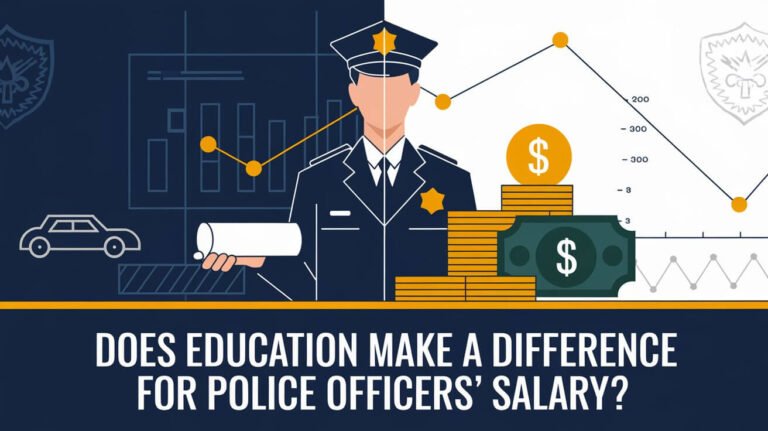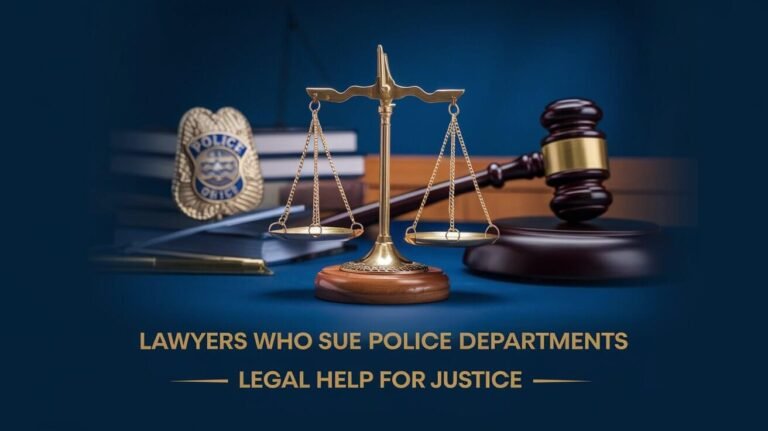School Resource Officers vs Regular Police Officers: What’s the Difference?

Ensuring a safe and secure learning environment for students has become a top priority in educational institutions across the United States. In recent years, the presence of law enforcement personnel, particularly school resource officers (SROs), has emerged as a widely adopted strategy to address this concern. However, the exact role of SROs and how they differ from regular police officers often remains unclear to many. So, what’s the difference between school resource officers and regular police officers working in schools?
The key distinction lies in the specialized training and multifaceted role that SROs play within the educational setting. While regular police officers primarily focus on law enforcement duties, SROs are trained to balance law enforcement responsibilities with teaching, mentoring, and counseling students, all while fostering a positive school climate.
This guide examines the differences between school resource officers and regular police officers. It covers their roles, training, impact on school safety, policies, controversies around SRO programs, best practices, and alternative approaches for creating secure, supportive learning spaces for students.”
Understanding School Resource Officers (SROs)
A school resource officer (SRO) is a sworn law enforcement officer who has received specialized training to work within an educational setting. Unlike regular police officers, SROs are specifically assigned to one or more schools, where they play a multifaceted role that extends beyond traditional law enforcement duties.
The primary purpose of SROs is to cultivate a safe and secure learning environment for students, teachers, and staff. However, their responsibilities go beyond merely responding to incidents or maintaining order. SROs are tasked with:
- Law Enforcement Duties: SROs have the authority to make arrests, respond to calls for service, and document incidents that occur within their jurisdiction, similar to regular police officers.
- Teaching Law-Related Topics: SROs often serve as educators, conducting classroom presentations and discussions on various law-related subjects, such as bullying, substance abuse, internet safety, and youth-related issues.
- Mentoring and Counseling Students: SROs act as informal advisers and role models, providing guidance and support to students who may be facing personal or academic challenges.
- Crime Prevention and Ensuring School Safety: SROs work closely with school administrators and staff to develop and implement strategies for preventing criminal activities and ensuring the overall safety and security of the school community.
The Rise of SROs in Schools
The concept of school resource officers is not new, but their presence in educational institutions has grown significantly in recent decades. The rise of SRO programs can be attributed to several factors, including:
- School Shootings and Increased Safety Concerns: Tragic events such as the Columbine High School massacre in 1999 and the Sandy Hook Elementary School shooting in 2012 have heightened concerns about school safety and prompted districts to implement measures to prevent and respond to such incidents.
- Efforts to Improve Community-Police Relations: SRO programs have been viewed as an opportunity to foster positive relationships between law enforcement and the community, particularly among youth.
- Federal Funding and Initiatives: In the aftermath of high-profile school shootings, the federal government has allocated significant funding and resources to support the implementation of SRO programs across the nation.
According to the National Center for Education Statistics, in the 2015-2016 school year, approximately 42% of public schools in the United States had at least one SRO present at least once per week. This figure highlights the widespread adoption of SRO programs as a means to address school safety concerns.
Training and Qualifications of SROs
One of the key distinctions between school resource officers and regular police officers lies in their specialized training. SROs undergo extensive training that prepares them to navigate the unique challenges and dynamics of an educational environment.
The training curriculum for SROs typically includes:
- Student Counseling and Conflict Resolution: SROs learn techniques for effective communication, active listening, and conflict resolution, enabling them to defuse tense situations and provide guidance to students.
- Crisis Management and Emergency Response: SROs receive training in crisis management, including responding to emergencies such as active shooter situations, bomb threats, and other critical incidents that may occur on school grounds.
- Classroom Management and Teaching Strategies: SROs are taught classroom management techniques and strategies for delivering effective presentations and lessons on law-related topics to students of various ages and backgrounds.
- Youth Development and Mentorship: SROs learn about the unique developmental needs and challenges faced by youth, equipping them to serve as positive role models and mentors for students.
- Cultural Awareness and Diversity Training: SROs undergo training to develop cultural competency and sensitivity, enabling them to effectively interact with and understand the diverse student populations they serve.
In contrast, regular police officers typically receive more general law enforcement training, which may not necessarily address the specific challenges and dynamics of working within an educational setting.
Roles and Responsibilities of SROs
While the primary role of school resource officers is to ensure a safe and secure learning environment, their responsibilities extend far beyond traditional law enforcement duties. Here are some of the key roles and responsibilities of SROs:
- Law Enforcement Duties: As sworn law enforcement officers, SROs have the authority to make arrests, respond to calls for service, and document incidents that occur within their jurisdiction, similar to regular police officers.
- Teaching Law-Related Topics: SROs often serve as educators, conducting classroom presentations and discussions on various law-related subjects, such as bullying, substance abuse, internet safety, and youth-related issues. By educating students on these topics, SROs aim to promote responsible citizenship and prevent criminal behavior.
- Mentoring and Counseling Students: SROs act as informal advisers and role models, providing guidance and support to students who may be facing personal or academic challenges. They may offer counseling on a limited basis and serve as a resource for connecting students and families with appropriate community services.
- Collaboration with School Administrators and Staff: SROs work closely with school administrators, teachers, and counselors to develop and implement strategies for maintaining a safe and positive school climate. They may participate in staff training, provide input on school safety policies, and serve as liaisons between the school and law enforcement agencies.
- Emergency Planning and Crisis Response: SROs play a crucial role in developing and implementing emergency response plans for various scenarios, such as active shooter situations, bomb threats, or natural disasters. They may coordinate with local law enforcement agencies and emergency responders to ensure effective communication and response protocols.
- Community Outreach and Relationship Building: SROs serve as a bridge between the school community and law enforcement agencies, fostering positive relationships and promoting open communication. They may participate in community events, parent meetings, and other outreach initiatives to build trust and rapport with students, families, and the broader community.
By fulfilling these diverse roles, SROs aim to create a comprehensive approach to school safety that extends beyond traditional law enforcement strategies.
Benefits of SROs in Schools
The presence of school resource officers in educational institutions can provide numerous benefits to students, staff, and the overall school community. Some of the potential advantages of having SROs in schools include:
- Improved School Safety and Security: SROs play a crucial role in enhancing school safety by deterring and responding to potential threats, enforcing school policies, and providing a visible law enforcement presence on campus.
- Positive Relationships with Students and Community: SROs have the opportunity to build positive relationships with students, serving as mentors, role models, and trusted sources of guidance. This can foster a sense of trust and open communication between students and law enforcement.
- Early Intervention and Prevention of Criminal Behavior: By working closely with students and staff, SROs can identify potential issues or risk factors early on and provide targeted interventions or referrals to appropriate resources, helping to prevent criminal behavior and promote positive outcomes.
- Support for Vulnerable Students and Families: SROs can serve as a valuable resource for connecting students and families with community services and support systems, such as mental health resources, substance abuse programs, or social services.
- Collaboration and Information Sharing: SROs facilitate collaboration and information sharing between schools, law enforcement agencies, and other community stakeholders, enabling a more coordinated and effective approach to addressing school safety concerns.
- Emergency Preparedness and Response: SROs play a critical role in developing and implementing emergency response plans, ensuring that schools are prepared to respond effectively to various crises.
SRO programs work best when there are clear policies, training, and oversight. This ensures that SROs are qualified, know their limits, and create a positive school environment.
Controversies and Criticisms of SRO Programs
SRO programs aim to make schools safer and build positive relationships between police and students, but they have faced criticisms and controversies. Major concerns include:
- The “School-to-Prison Pipeline”: Critics argue that the presence of SROs in schools contributes to the “school-to-prison pipeline,” a phenomenon where students, particularly those from minority backgrounds, are funneled into the criminal justice system for minor disciplinary infractions that could have been better addressed through alternative means.
- Incidents of Excessive Force or Misconduct: There have been several high-profile cases of SROs using excessive force or engaging in misconduct toward students, raising concerns about the potential for abuse of power and the appropriateness of having armed law enforcement officers in educational settings.
- Racial Disparities in Disciplinary Actions: Studies have shown that minority students, particularly Black and Latino students, are disproportionately subject to disciplinary actions, including arrests and referrals to law enforcement when SROs are present in schools.
- Potential Criminalization of Minor Student Misbehavior: Critics argue that the presence of SROs can lead to the criminalization of minor student misbehavior, such as disruptive behavior or dress code violations, which could be better addressed through non-punitive disciplinary measures.
- Impact on School Climate and Student Well-being: Some experts suggest that the presence of SROs in schools can create an environment of fear and distrust, particularly for students from marginalized communities or those with negative experiences with law enforcement, potentially hindering their ability to learn and thrive.
Policies and Regulations Governing SROs
To address the concerns surrounding SRO programs and ensure that they operate within appropriate boundaries, various policies and regulations have been implemented at the federal, state, and local levels. These include:
- Memorandums of Understanding (MOUs): Many school districts and law enforcement agencies establish MOUs that outline the roles, responsibilities, and limitations of SROs within the school setting. These MOUs aim to clarify the scope of SRO duties and promote accountability.
- Federal Guidelines and Initiatives: The U.S. Department of Education and the Department of Justice have developed guidelines and initiatives, such as the Safe School-based Enforcement through Collaboration, Understanding, and Respect (SECURe) rubrics, to provide best practices and recommendations for implementing effective and responsible SRO programs.
- State Laws and Training Requirements: Some states have enacted laws and regulations specific to SROs, mandating specialized training, establishing certification requirements, or defining the scope of their authority within schools.
- School District Policies: Individual school districts may implement their policies and protocols governing the roles, responsibilities, and conduct of SROs, aligning with local needs and community values.
These policies and regulations aim to strike a balance between ensuring school safety and protecting the rights and well-being of students. However, their effectiveness and implementation can vary across different jurisdictions.
Balancing School Safety and Student Rights
The presence of SROs in schools has sparked debates around the balance between maintaining a safe learning environment and protecting the rights and civil liberties of students. Some key considerations in this regard include:
- Student Privacy and Civil Liberties: Concerns have been raised about the potential infringement of students’ privacy and civil rights, such as search and seizure protections or the right to due process when SROs are involved in disciplinary matters.
- Criminalizing Student Behavior: Critics argue that the involvement of SROs in disciplinary issues can lead to the unnecessary criminalization of student behavior, particularly for minor infractions that could be better addressed through alternative disciplinary measures or restorative justice practices.
- Disproportionate Impact on Marginalized Students: Research has shown that the presence of SROs can disproportionately impact students from marginalized communities, such as racial and ethnic minorities, students with disabilities, or those from low-income backgrounds, contributing to existing disparities in disciplinary actions.
To address these concerns, it is essential to have clear policies and protocols in place that define the appropriate role and limitations of SROs in disciplinary matters. These policies should prioritize the use of non-punitive, restorative approaches and ensure that SROs are not involved in routine disciplinary issues that can be effectively handled by school administrators and staff.
Promote positive school climates, build trust between students and SROs, and train SROs in cultural competency, de-escalation techniques, and trauma-informed practices.
The Role of Regular Police Officers in Schools
Regular police officers may be involved in school-related matters in certain situations, such as:
- Responding to Criminal Incidents or Emergencies: In the event of a serious criminal incident or emergency, such as an active shooter, regular police officers may be called upon to respond and provide assistance to SROs or school staff.
- Conducting Investigations: Regular police officers may be involved in investigating criminal incidents that occur on school grounds, such as assaults, thefts, or drug-related offenses, particularly if the incident falls outside the jurisdiction or expertise of the SRO.
- Providing Additional Security: During high-risk events or situations that require additional security measures, regular police officers may be temporarily assigned to supplement the presence of SROs or provide additional support.
- Assisting with Traffic Control or Crowd Management: In situations involving large crowds or traffic concerns, such as during school events or dismissal times, regular police officers may be called upon to assist with traffic control or crowd management.
Regular police officers may be present in schools for specific incidents or situations, but their roles and responsibilities differ from those of SROs. They typically lack specialized training and familiarity with the school environment, and their involvement is limited to specific cases that require their expertise or resources.
Best Practices for SRO Programs
To ensure that SRO programs are effective, responsible, and aligned with the best interests of students and the school community, it is essential to implement best practices. These may include:
- Fostering Positive Relationships: Encouraging SROs to build positive relationships with students, staff, and families through open communication, mentorship, and community engagement can help create a supportive and trusting environment.
- Ongoing Training and Professional Development: Providing SROs with continuous training on topics such as de-escalation techniques, cultural competency, trauma-informed practices, and youth development can help them better understand and respond to the unique needs of the student population.
- Collaborative Approach: Promoting collaboration between SROs, school administrators, mental health professionals, and community stakeholders can ensure a comprehensive and coordinated approach to addressing school safety and student well-being.
- Clear Policies and Protocols: Establishing clear policies and protocols that define the roles, responsibilities, and limitations of SROs, as well as their involvement in disciplinary matters, can help prevent overreach and ensure accountability.
- Data Collection and Evaluation: Regularly collecting and analyzing data on SRO programs, including disciplinary actions, arrests, and student perceptions, can help identify areas for improvement and inform evidence-based decision-making.
- Community Engagement and Transparency: Involving the broader community, including students, parents, and community organizations, in the development and oversight of SRO programs can foster trust, transparency, and alignment with community values.
By implementing these best practices, SRO programs can better achieve their intended goals of creating safe and supportive learning environments while respecting the rights and well-being of all students.
Alternatives to SRO Programs
Some schools and districts have explored alternative approaches to address school safety concerns, which may be used alongside or instead of SRO programs:
- School Counselors and Mental Health Professionals: Increasing the presence of school counselors, social workers, and mental health professionals can provide students with access to support services, counseling, and early intervention for behavioral or emotional issues, potentially reducing the need for law enforcement involvement.
- Restorative Justice and Positive Behavior Interventions: Implementing restorative justice practices and positive behavior interventions and supports (PBIS) can promote non-punitive approaches to addressing student behavior, focusing on accountability, healing, and building positive relationships within the school community.
- Parent and Community Involvement: Encouraging active parent and community involvement in school safety initiatives can foster a sense of collective responsibility and provide additional resources and support for creating a positive school climate.
- Alternative Conflict Resolution Strategies: Implementing alternative conflict resolution strategies, such as peer mediation programs or restorative circles, can help students develop critical problem-solving and communication skills while addressing conflicts in a non-punitive manner.
- Environmental Design and Security Measures: Investing in physical security measures, such as access control systems, surveillance cameras, and improved lighting, can enhance school safety without relying solely on law enforcement presence.
These alternatives are not mutually exclusive and can be used alongside SRO programs or as part of a comprehensive approach to school safety. The most effective strategies involve a combination of measures tailored to each school community’s specific needs and circumstances.






